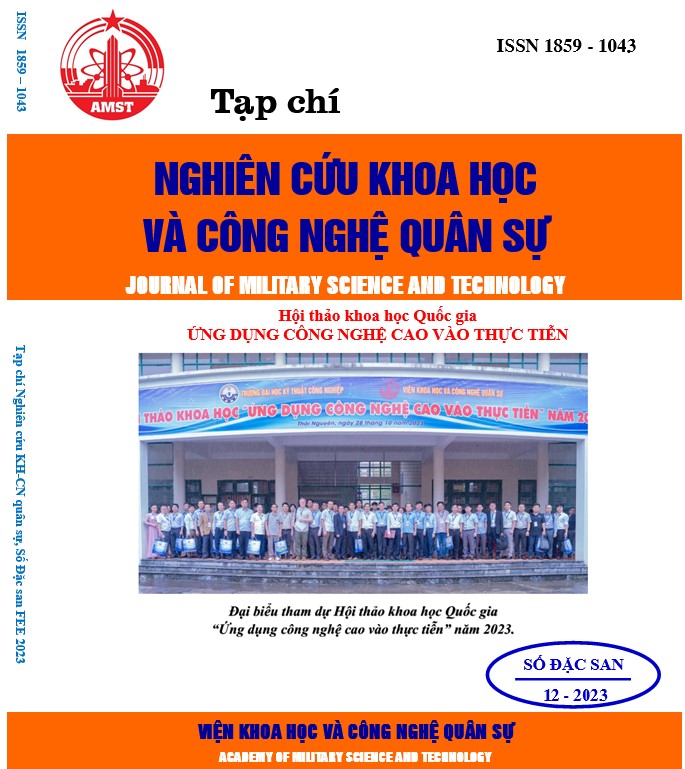Synthesis, properties of complexes of mixed salicylic and 2,2’-Dipyridine-N-oxide with some heavy rare earth
254 viewsDOI:
https://doi.org/10.54939/1859-1043.j.mst.FEE.2023.216-222Keywords:
Rare earth; Complex; Salicylate; 2;2’-Dipyridine-N-oxide.Abstract
This paper presents the synthesis of several complexes of Ln (III) (Ln: Tb, Dy, Yb) with mixed ligands (salicylic and 2,2’-Dipyridine-N-oxide). They are represented by the general formula of Ln(Sal)3(DipyO).2H2O (Ln: Tb, Dy) and Yb(Sal)3(DipyO) (Sal-: Salicylate, DipyO: 2,2’-Dipyridine-N-oxide). The characterization of these complexes has been studied by IR, thermal analysis, mass, and emission spectroscopy approaches. The results from IR spectroscopy suggest that complexes have been synthesized successfully, and the coordination modes of the ligands to Ln(III) centres have been investigated by IR spectroscopy. Mass spectroscopy findings show that the synthesized complexes are monomers and that they are stable. In addition, thermal analysis indicates that they are all quite stable to heat. The emission spectra of the Tb(Sal)3(DipyO).2H2O display three bands arising from the 5D4 → 7F5 dominant transition located at 545 nm, the weaker 5D4 → 7F6, 5D4 → 7F4 transitions located at 490 and 587 nm, respectively. The luminescent spectra of the Dy(Sal)3(DipyO).2H2O displayed one weak band at 450 nm, arising from 4F9/2 → 6H15/2 transition. The emission spectra of the Yb(Sal)3(DipyO) displayed one band at 454 nm, meaning the 2F5/2→2I7/2 energy level of Yb3+ was observed. The results of our study demonstrate that these complexes exhibit room-temperature photoluminescence.
References
[1]. Na Zhao et al, “Synthesis, crystal structure and properties of two ternary rare earth complexes with aromatic acid and 1,10-phenanthroline”, J. of Alloys and Compounds, Vol. 463, No. (1-2), pp. 338-342, (2008). DOI: https://doi.org/10.1016/j.jallcom.2007.09.008
[2]. Liming Zhang et al, “A terbium (III) complex with triphenylamine-functionalized ligand for organic electroluminescent device”, J. of Luminescence, Vol. 128, pp. 620-624, (2008). DOI: https://doi.org/10.1016/j.jlumin.2007.10.008
[3]. Bing Yan et al, “Spectroscopic Study on the Photophysical Properties of Lanthanide Complexes with 2, 2/ -Bipyridine-N, N/-dioxide”, J. of Fluorescence, Vol. 14, No. 3, pp. 289-294, (2004). DOI: https://doi.org/10.1023/B:JOFL.0000024561.55183.26
[4]. Linyan Yang et al, “Synthesis, characterization and cell imaging properties of rare earth compounds based on hydroxamate ligand”, J. of Rare Earths, Vol. 36, No 4, pp. 418-423, (2018). DOI: https://doi.org/10.1016/j.jre.2017.11.004
[5]. Yasuchika Hasegawa, et al, “Strategies for the design of luminesent lanthanide (III) complexes and their photonic applications”, J. of photochemistry and Photobiology, Vol. 5, pp. 183-202, (2004). DOI: https://doi.org/10.1016/j.jphotochemrev.2004.10.003
[6]. Nguyễn Thị Hiền Lan, Nguyễn Trường Giang, “Tổng hợp, tính chất và khả năng phát quang của phức chất axetylsalixylat của Tb(III), Yb(III)”, Tạp chí Phân tích Hóa, Lý và Sinh học, T.24, số 2, tr. 121-125, (2019).
[7]. Nguyễn Thị Hiền Lan, Nguyễn Thị Hoàn. “Tổng hợp, tính chất và khả năng phát quang của phức chất hỗn hợp phối tử salixylic và 2,2′-dipyridyl N,N′-dioxit của Dy (III), Er(III), Tb(III), Yb(III)”, TC. Phân tích Hóa, Lý và Sinh học, T.26, số 4B, tr. 6-10, (2021).
[8]. Nguyễn Thị Hiền Lan, Phạm Thị Nhung, “Tổng hợp và nghiên cứu tính chất phức chất 2-phenoxybenzoat của Tb(III), Yb(III) và phức chất hỗn hợp của chúng với o-phenantrolin”, TC. Phân tích Hóa, Lý và Sinh học, T. 21, số 1, tr. 112-119, (2016).







